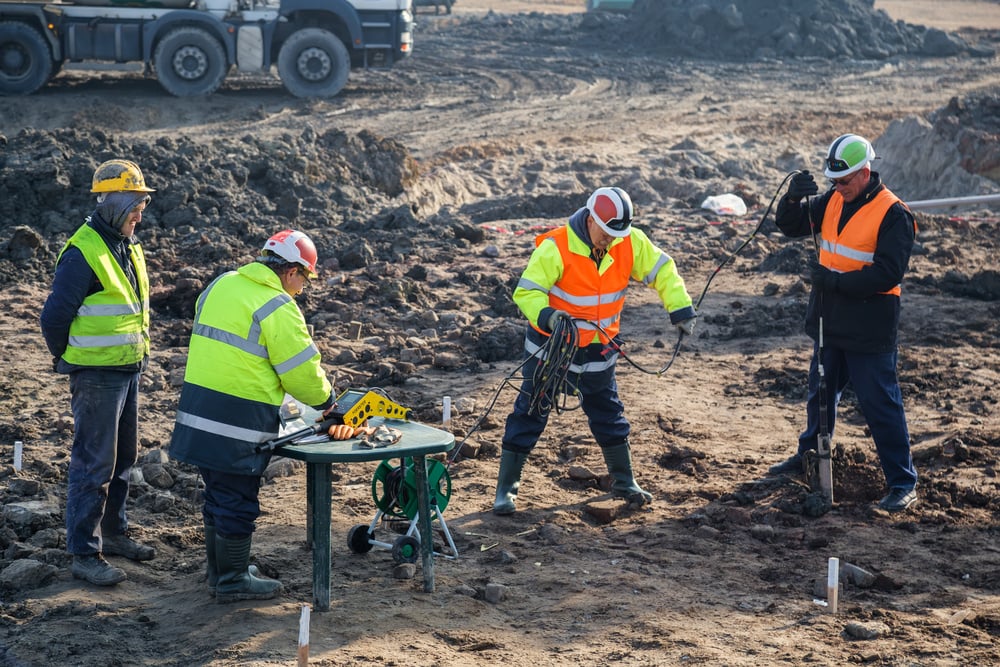Fascination About Geotechnical Engineering For Construction Projects
Fascination About Geotechnical Engineering For Construction Projects
Blog Article
Not known Incorrect Statements About Geotechnical Engineering For Construction Projects
Table of ContentsAll About Geotechnical Engineering For Construction ProjectsThe smart Trick of Geotechnical Engineering For Construction Projects That Nobody is Talking AboutOur Geotechnical Engineering For Construction Projects PDFsSee This Report about Geotechnical Engineering For Construction ProjectsExcitement About Geotechnical Engineering For Construction ProjectsAn Unbiased View of Geotechnical Engineering For Construction ProjectsNot known Facts About Geotechnical Engineering For Construction Projects
Principles and Technique of Ground Renovation. Ground Enhancement Concepts And Applications In Asia. Style evaluation in rock technicians.Cengage Knowing, Stamford, 666 p. Atkinson, J., 2007. The mechanics of dirts and foundations. The Observational Method in ground design concepts and applications.
Not known Factual Statements About Geotechnical Engineering For Construction Projects
Research laboratory and field testing plays a crucial role in this procedure. By removing examples from the earth's subsurface and using a collection of tests, geotechnical designers can anticipate the behaviour of soil layers and review their viability for different construction endeavours. The essence of geotechnical engineering in civil design can not be overemphasized, attributable to a number of factors: The initial action in any kind of geotechnical study entails figuring out the soil kind at the construction site.
Understanding these attributes makes certain that just suitable soil types are selected for the growth, thus preventing potential architectural failings. The foundation acts as the bedrock of any building and construction job. Choosing the proper structure type is a decision that depends upon the extensive evaluation offered by geotechnical engineering. This guarantees the durability and security of frameworks by suiting the tons they will birth.

Geotechnical website examination is an important action in the planning and implementation of any type of building and construction task. It includes the collection and evaluation of information associated with the physical residential or commercial properties of dirt and rock beneath a suggested building and construction website. This details is important for the layout and building of secure, stable, and sustainable structures.
The Ultimate Guide To Geotechnical Engineering For Construction Projects
In this blog site, we will explore the importance of geotechnical site examination, its various components, and just how it benefits building tasks. Geotechnical site examination, also recognized as subsurface exploration, involves a series of activities focused on figuring out the dirt, rock, and groundwater conditions at a building site. The primary goals are to identify possible geotechnical threats, assess the engineering buildings of subsurface materials, and give suggestions for the layout and building and construction of foundations, maintaining walls, and various other frameworks.
The workdesk study aids in determining potential geotechnical issues and planning the succeeding fieldwork. This includes observing the topography, water drainage patterns, existing structures, plant life, and any indicators of instability or disintegration.
Geotechnical Engineering For Construction Projects for Beginners
Superficial test pits are excavated to straight observe and example the dirt and rock. This approach is valuable for examining the upper layers of the subsurface and identifying near-surface risks. Non-invasive geophysical techniques, such as seismic refraction, ground-penetrating radar (GPR), and electric resistivity tomography (ERT), are utilized to map subsurface problems and identify abnormalities.
Dirt and rock samples collected during the field examination are subjected to lab screening to establish their physical and mechanical buildings. These tests offer essential information for geotechnical evaluation and design.
The key benefit of geotechnical site examination is guaranteeing the safety and stability of frameworks. By comprehending the subsurface conditions, designers can develop structures and various other architectural components that can withstand the loads and environmental pressures they will be subjected to. This reduces the risk of settlement, subsidence, and structural failure.
Some Ideas on Geotechnical Engineering For Construction Projects You Should Know
This guarantees reliable and safe building methods. Geotechnical website investigations are frequently required by developing codes and laws.
This information is indispensable for task supervisors, engineers, and service providers in establishing reasonable schedules, budget plans, and backup strategies. Geotechnical Engineering for Construction Projects. High-Rise Structure in a Coastal AreaIn a coastal city, a skyscraper domestic building was intended on a site with thought loose sand down payments and a high water table. A detailed geotechnical examination, including borehole exploration, CPT, and geophysical studies, was performed
Getting The Geotechnical Engineering For Construction Projects To Work
Based upon these searchings for, the foundation layout was customized to consist of deep heap foundations extending right into secure strata, and ground enhancement strategies, such as vibro-compaction, were executed to alleviate liquefaction dangers. This positive method ensured the safety and security and security of the structure while preventing expensive post-construction remediation. Infrastructure Growth on a Sloping TerrainA significant framework project, involving the building of a freeway and bridges, was planned click here to read on a hilly surface with steep inclines.

The Leaning Tower of Pisa (Italy), a legendary architectural wonder, is notorious for its unintentional tilt from considerable geotechnical issues. The tower's structure was improperly made to manage the soft, unpredictable dirt beneath it, leading to uneven negotiation and its site web unique lean. Our world is populated with remarkable infrastructure projectsfrom looming high-rise buildings to stretching bridgesall standing statement to the development of the numerous building and construction equipment and approaches available.
Geotechnical engineering is a customized area within civil engineering that focuses on studying the habits of planet materials. This branch delves deep into the groundinvestigating just how the soil, rock, and groundwater at a building site can influenceand be affected bythe infrastructure that we put up on and right into them. Before a solitary block is laid or a concrete structure put, geotechnical engineers probe right into the earthgathering critical information regarding the website's soil structure, rock framework, and groundwater levels.
Not known Details About Geotechnical Engineering For Construction Projects

is a device made use of to evaluate the stability and load-bearing ability of heaps throughout installation, leveraging the concept of wave proliferation. It optimizes construction efficiency by providing real-time assessments, therefore making certain secure and reliable stack foundations. One of the functional applications of geotechnical engineering involves choosing and performing the right methods for structure construction.
Pile driving represents even more than the simple act of placing architectural components right into the ground. However, it is a carefully orchestrated procedure of transferring a structure's load past the much less secure soil layers more detailed to the surfacedown to the extra significant strata that lie below. When it comes to heap driving, take into consideration exactly site here how geotechnical designers adeptly use this method to evenly disperse the structure's weight.
Report this page